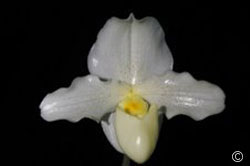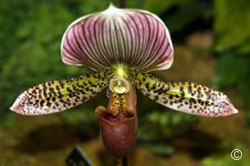
Paphiopedilums, commonly called lady slipper orchids, are native to tropical Asia. They are perhaps best known for their leaves, which are sometimes mottled or patterned, and unusual, waxy flowers which are striped, spotted or solid in color. The blossom size and number of flowers vary by variety, but they usually bear one to three or more flowers per flowering stem. They come in all colors except blue and true red. In their native habitat, they are most often terrestrial, meaning that they grow in well-drained ground locations. Paphiopedilum leaves are leathery but not thick, like other varieties.
Paphiopedilum orchids perform best in moderate bright filtered light to low light situations, such as an east or north window, or in diffused sunlight or under broad-spectrum fluorescent lights. Use a commercially available potting mix for terrestrial orchids or make one comprised of medium to fine grade redwood bark chips, granulated charcoal, coarse peat moss and perlite. Paphiopedilums have fewer roots than other orchids and are very susceptible to root rot, so it is important that the potting mix drain very well. Do not allow to dry out.

This orchid variety performs well in typical household temperatures. Plants with patterned or mottled leaves like temperatures at 65 to 70 degrees Fahrenheit during the day and 58 to 60 degrees at night. Plants with plain green leaves generally require cooler conditions. These orchids will thrive in 50 to 80 percent relative humidity. Use a humidifier or place the pot on a tray filled with pebbles and water to increase humidity.
Keep the water level in the tray below the bottom of the pot to prevent water wicking into the pot which, over time, may lead to root rot.
Paphiopedilum are light feeders. When new growth is forming, fertilize monthly with a water soluble, commercial orchid formulation; or use a 20-20-20 formulation at ¼ strength.
Paphiopedilums generally bloom only once a year, but the season of bloom varies by species or hybrid. Repot these orchids every two to three years when new growth begins.
Mealybugs and scale insects occasionally bother paphiopedilums. They are also susceptible to viral infections and root rot.
For “Viruses in plants” refer to message number 1443.
For more information, see the following Planttalk Colorado™ video(s).
For more information, see the following Colorado State University Extension fact sheet(s).
- Insect Control: Soaps and Detergents
- Insect Control: Horticultural Oils
- Greenhouse Plant Viruses (TSWV/INSV)



